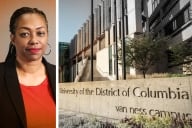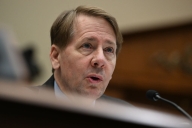You have /5 articles left.
Sign up for a free account or log in.

President Biden wants to provide student borrowers with some form of debt relief, but the regulatory path to lower balances is complex and will take a while.
Photo illustration by Justin Morrison/Inside Higher Ed | Getty Images | Rawpixel
The Education Department clarified Wednesday what kind of debt relief it’s considering after an advisory committee pushed for more specifics.
Essentially, the department wants to cancel some or all of borrowers’ outstanding loan balances if they fall into certain categories, such as spending several years in repayment or experiencing hardship. Following that clarification, the 16-member advisory committee tasked to negotiate with the department over its plan started to dig more into the specifics of how to provide that relief—and which borrowers will get it.
This week’s negotiation sessions, which kicked off Tuesday, were more of an opportunity for the department to listen to the committee’s feedback rather than hammer out specific details of a plan. Department officials plan to use feedback from the committee to draft proposed regulations that will be released prior to the committee’s next meeting on Nov. 7.
The initial categories of borrowers who stand to have some of all their loans canceled are:
- Those whose balances have increased beyond what they originally borrowed,
- Borrowers who would be eligible for relief under an income-driven repayment plan but didn’t apply,
- Those experiencing hardship ,
- Borrowers who entered repayment several years ago and
- Those who attended a college program that didn’t provide a sufficient financial value.
Committee members largely agreed with the department’s categories of borrowers who deserve help but urged the agency to also provide relief to those with Parent PLUS loans and federal loans not held by the department. The advisory committee represents 16 stakeholder groups including borrowers, civil rights organizations, consumer advocates and the companies that manage student loans.
“It’s important that the department be transparent as it drafts these regulations about the strength of the legal justification,” said Scott Buchanan, executive director of the Student Loan Servicing Alliance, who represents servicers on the committee. “We can’t go down the path again where we’re making promises to borrowers that can’t be kept. We heard that anger and frustration loudly.”
This new approach, under the Higher Education Act of 1965, likely would help more borrowers than the department’s more targeted debt-discharge programs, but it wouldn’t be as expansive as President Biden’s initial plan for one-time student loan forgiveness announced in August 2022 under a separate law.
Thus far, the Biden administration has forgiven about $127 billion in student loans for 3.3 million borrowers through the targeted programs and other fixes. Nearly 43 million borrowers would have benefited from the one-time student loan forgiveness plan that the Supreme Court struck down over the summer. The Education Department estimated that the relief would have cost about $305 billion; other groups put the price tag at more than $400 billion.
Following the Supreme Court’s decision, Biden opted to try again to provide some form of broader relief—this time through the Higher Education Act, which allows the education secretary to “compromise” or “waive” claims against borrowers. That meant the administration had to use negotiated rule making, a complex and lengthy process, to create new regulations.
Who Should Get Debt Relief?
The department asked the committee Wednesday to weigh in on how to help borrowers with older loans, along with those who attended a program that didn’t provide a sufficient financial value and those with other types of hardship.
The Next Steps to Make a Policy
As part of negotiated rule making, the Education Department must:
Put out a public notice about intent to form a committee and hold a public hearingHold a public hearingPublish notice inviting nominations for negotiatorsPick the negotiators- Hold negotiated rule-making sessions (current step)
- Write the proposed regulations
- Publish those regulations for public comment, which lasts at least 30 days
- Read and respond to the comments; revise the regulations as needed
- Publish the final rule. Rules need to be published by Nov. 1 in order to take effect July 1 of the following year, but the department can implement rules early.
Several committee members said that medical debt and other expenses—such as childcare, being in prison and chronic illness—should count as a hardship for borrowers and qualify them for either full or partial cancellation.
They also focused on ways in which borrowers, particularly those who took out loans before 2010, have been failed by the student loan system. Any plan should be easy for the borrowers to access, several committee members said, and the department should use other federal data sources—such as whether a borrower is on Medicaid—to gauge financial hardship.
“Making people beg is unseemly; it should be quick,” said John Whitelaw, advocacy director at the Community Legal Aid Society in Delaware, who represents individuals with disabilities on the committee.
Some committee members suggested that the department should cancel loans taken out before July 1, 2010, arguing that they are a burden on the system and not collectible. The federal government started issuing loans directly to students in 2010.
Jessica Ranucci, an attorney at New York Legal Assistance Group representing consumer advocates on the committee, argued that the department should cancel loans when the payment or loan history is missing, noting that her office has seen “serious issues” with the loan records.
“People don’t have paperwork from the ’80s, from the ’90s, from servicers that no longer exist, or from guarantee agencies that are no longer guarantee agencies,” she said. “So I think that it’s really important not just from an ethical perspective but from a legal perspective to look at that.”
As of 2021, about 4.4 million borrowers had been in repayment for more than 20 years, said Kyra Taylor, a staff attorney at the National Consumer Law Center who is representing legal assistance groups on the committee. “These old loans bear the scars of servicing misconduct,” Taylor said. “They also bear the scars of policies that were fixed for newer loans, but where those policies did not provide retroactive relief.”
Taylor suggested that the department discharge the loans of borrowers who didn’t complete their degrees, given that those borrowers are more likely to default.
Ashley Pizzuti, a student loan reform advocate and committee member representing borrowers who attended programs of two years or less, noted that current relief programs such as borrower defense require individuals to prove they were misled by their college in order to receive relief. She wants to see the department be more proactive in helping students who attended schools that have closed or have engaged in predatory practices.
“The cards are stacked against [borrowers],” she said. “Schools have shut down and students are on the hook of these loans.”
Pizzuti added that telling borrowers they would have some of their loans forgiven, only to have the Supreme Court nix that plan, could also be considered a hardship. “There’s a group of people who have backed themselves into a corner assuming that they would not have these loans hanging over them,” she said.
‘Blatant Political Process’
Ahead of the committee’s Tuesday meeting, several Republican senators, led by Iowa senator Chuck Grassley, criticized the rule-making effort as an attempt to subvert the U.S. Constitution and deemed the committee “a blatantly biased panel.”
“Negotiated rulemaking is meant to balance the concerns of disparate groups as they attempt to reach an agreement on regulatory provisions regarding Federal Student Aid,” the senators wrote in a letter to Education Secretary Miguel Cardona. “However, the panel of 14 negotiators selected by the Department consists overwhelmingly of borrowers and representatives of institutions of higher education who directly stand to gain from enabling wide parameters for forgiveness on student loans and conveniently provide you with a fig leaf of political cover for your pre-stated goal of this rulemaking.
Committee’s Next Meetings
- Nov. 6 & 7
- Dec. 11 & 12
“We are gravely concerned that the department is undertaking a blatant political process with a predetermined outcome to achieve one of the President’s campaign promises at all costs,” the letter said. “We urge you again to abandon this mockery of a rulemaking process. It is unfair to string student loan borrowers along for political purposes in a process that is undoubtedly deficient to stand up in a court of law.”
Jim Blew, founder of the Defense of Freedom Institute, a conservative think tank, echoed Grassley’s concerns after the meeting opened up for public comment.
“To be clear, opponents to this process are concerned as well that some borrowers have been harmed by the federal student loan program,” said Blew, who worked in the Education Department during the Trump administration. “But we should be having a conversation about the source of this harm. That is bad federal policy and bad management by the U.S. [Education] Department and its vendors. Both of these root causes can and should be addressed. This committee, unfortunately, cannot effectively address either one.”
Blew was alone among public commenters in his concerns about the process. Others wanted to see the department go further to address the cost of college and future debt burdens on today’s students.
“How is a family supposed to do it?” Alice Smith, a parent, said of sending her four children to college. “How are these kids supposed to send themselves to college? It’s just not a sustainable thing right now … Do we prioritize education or do we prioritize university profits?”








